Text
SM3727 Wearables Final Documentation
SM3727 Wearables Group 7
Cheung Cheuk Wa Cherry 54794439
Lau Pak Yan Sean 54802708
Siu Wing Yi Zaberina 54807520
Demo Video:
https: //youtu.be/bjDhHefipV8
Prototyping Process:
https: //youtu.be/kK96cm3CNOg
Artist Statement / Motivation
“The Chromatic Aria” is a project targeting both music composers and people with color blindness. We would like to make a white scarf with a color sensor on the right for color sensing to generate different sounds and an accelerometer on the left for controlling the octave and sharp/flat.
We would like the people with color deficiency to have a higher self esteem. The colors they see may be different from what normal people see, but through generating the same sound using the same color, they may ‘see’ the same color as us.
Being in Hong Kong, 90% of teenagers got addicted to electronic devices, we hope that through moving the color sensor to the right upper side go the scarf, they may be more willing to embrace the nature, and the people around them.
Motivation:
To inspire composers with new melodies generated by random actions
To help people with colour-blindness feel and ‘listen’ to color
To drive people away from electronic devices, and pay more attention on their surroundings
Form: Scarf with pockets and hoodie attached
Material: Fabric, Lilypads, Conductive Threads, Color Sensor, Accerlerometer, Speakers
Size: Around 200 x 15 cm
Description:
Accelerometer attached at the left pocket
Color Sensor attached on the right upper side
Lilypad Arduino at the left upper side
Speakers at both sides of the ears

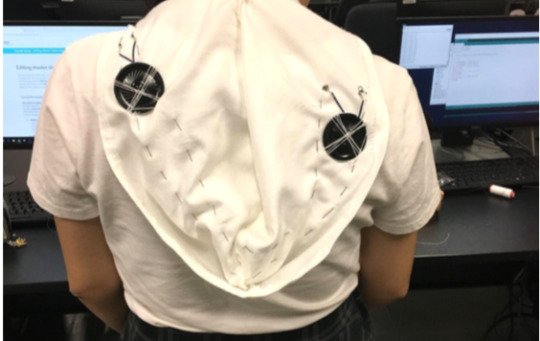

Generate Music through Colors
Sense colors using the colour sensor on the right to generate normal pitches.
Move the accelerometer up/down to control the octave.
Move the accelerometer left/right to control the sharp/flat.


0 notes
Text
SM3727 Wearables Work In Progress
SM3727 Wearables Group 7
Cheung Cheuk Wa Cherry 54794439
Lau Pak Yan Sean 54802708
Siu Wing Yi Zaberina 54807520
Short Introduction
Our Project
“The Chromatic Aria” is a project targeting both music composers and people with color blindness. We would like to make a white scarf with a color sensor on the right for color sensing to generate different sounds and an accelerometer on the left for controlling the pitch and loudness.
Our Group Members
We have three group members, Sean Lau, who is mainly responsible for the coding part. Zaberina Siu, who is mainly responsible for the aesthetic part, and Cherry Cheung, who is mainly responsible for the wire connections part. All three of us took part in the brainstorming and documentation parts of the project. We also worked together and helped each other whenever one of us overcame a problem.
Our Working Progress
We started by making a scarf from the white cloth we bought. Then, we tried to connect the components with Arduino Lilypad with the conductive threads. Instead of sewing the components directly on the cloth, we decided to tie the conductive threads on the positive and negative ends of the components first, so as to test if both the coding and the circuit works well together. After the whole testing conducted, we will sew all the components on the cloth to make our final product.
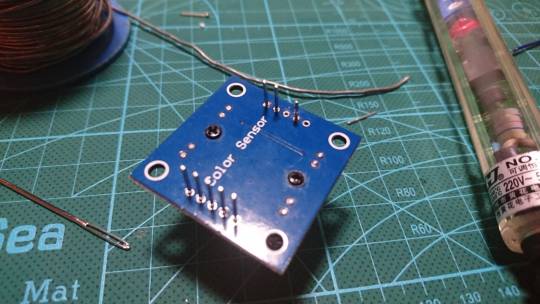

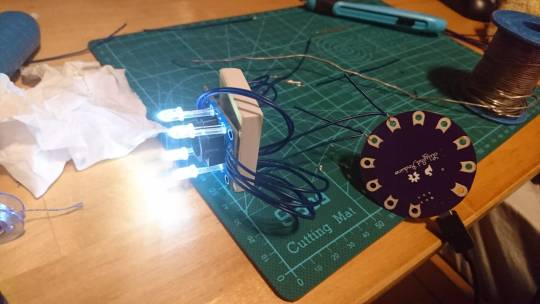

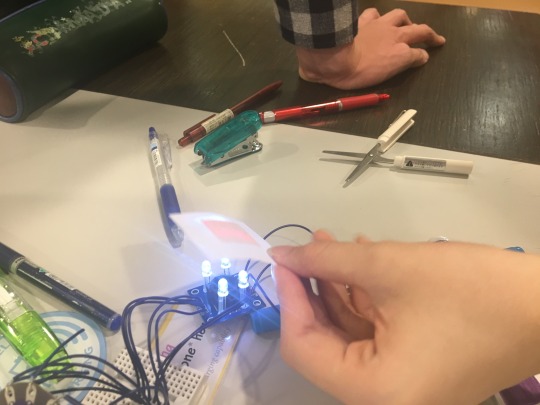
Working Progress Log

youtube
0 notes
Text
SM3727 Wearables - POV Reflection (Group 7)
Cheung Cheuk Wa Cherry (54794439)
Lau Pak Yan (54802708)
Siu Wing Yi Zaberina (54807520)
Google Doc for your reference:
https://docs.google.com/document/d/1BUmZHtQJKQvucRDGsmsQH44mDxwYzrWZuvpSJl9jNVk/edit?usp=sharing
Task 1:
Video Documentation (Making Process):
https://www.youtube.com/watch?v=jiaeQa8h3Sw
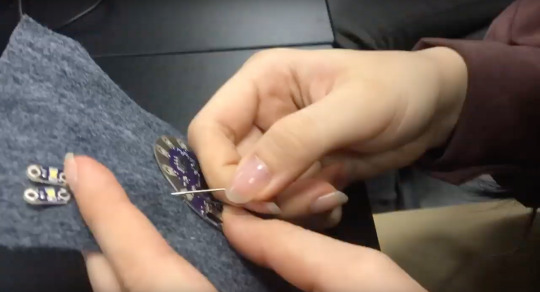


Details of Device:
Components:
7 LEDs
Arduino Lilypad USB
Conductive Thread
Battery
Cloth
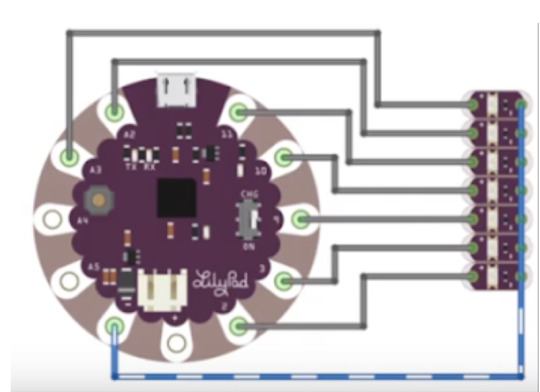
First, we connected the 7 LEDs’ positive end separately to different ports. Then, the negative ends were connected to the same negative port of the Arduino Lilypad USB. Afterwards, we connected the Arduino Lilypad to the computer and used the provided Arduino code to run. At last, we used a Sony a99 camera to take the long exposure photos for the final outcomes.
Final Long Exposure Outcomes:
Camera Used: Sony a99
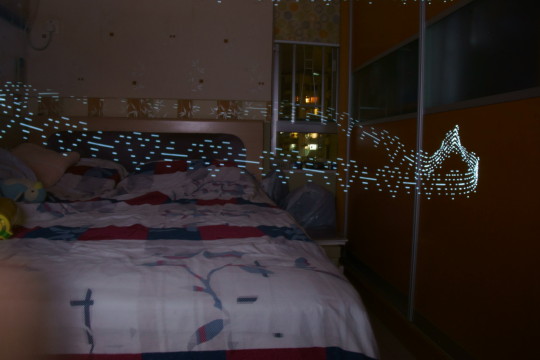
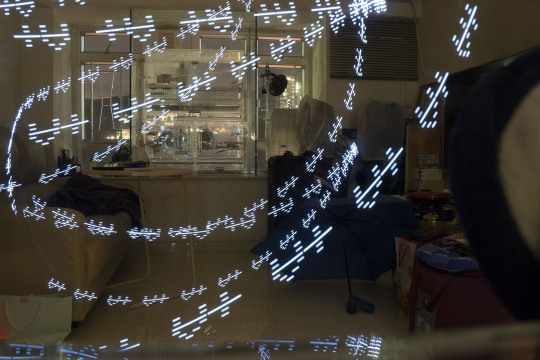
Task 2:
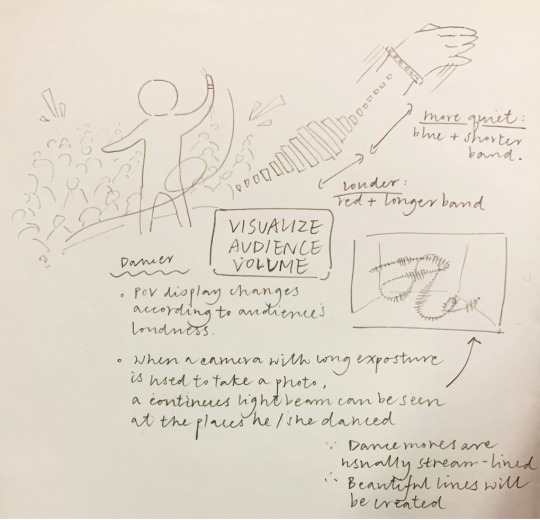
Proposed Project Description:
We propose to make a POV wristband which will change its color and shape according to the loudness of the surrounding sound. It can be used in concerts for celebrities. When the celebrity dances, the POV wristband will follow his/her movement to form a sequence of images, which would give a surprise to his/her fans when they take a long exposure photo of their beloved celebrities.
More importantly, we think that implementing this POV wristband for the celebrities, the amplitude of their songs, and their dance moves will be mixed with their fans’ cheers, in which the long exposure photo actually did capture the whole atmosphere and excitement of the concert.
How the modification can be done:
A sound intensity sensor can be added to the device and the LEDs on the device will be replaced by tri-colour LEDs. The signal gained from the sensor will control two parameters -- the hue and the number of LEDs to be turned on. When the sensor receives a high sound intensity, a lower hue value (around 0) will be sent to the LEDs. So, the LEDs will be displayed as red. When a lower intensity is received, a higher hue value (around 240) will be sent, which will turn the LEDs blue. Besides, a larger number of LEDs will light up with a higher sound intensity so that a larger bar representing the volume can be seen.
0 notes
Text
SM3727Wearables Soft Circuit Comment
Cheung Cheuk Wa Cherry 54794439
1. A demo video of your soft circuit.
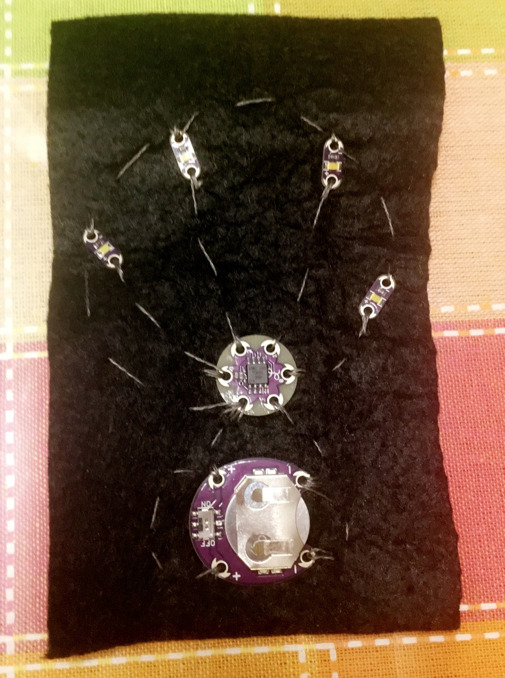
Video Documentation: https://youtu.be/9QtmgvXvzaA
The above link is the video documentation of the making of the firefly jar kit. I followed all the instructions online, yet I did not succeed in making the soft circuit. It may due to the lack of electrical energy from the battery, or that I did made a mistake during the process.
2. Discuss the advantages and the disadvantages of this way of circuit making.
Soft circuit makes technology flexible. It breaks though the traditional way of building an electrical circuit, in which allows the producers apply technology in different textures, such as fabric. Therefore, it brings infinite possibilities to the fashion world. Coding can be applied to the soft circuit, which can help a lot of disabled people, such as the visually impaired people or the deafblind. It also brings a lot of fun to the people around the world. It allows us to DIY in a simple way, which enables us to create clothes in a class by itself.
However, it has its shortcomings. Most of the soft circuit products require batteries and small components to operate. It would be better if there are other alternatives of charging, so as to minimize the inflexibility of the product. Apart from the energy source, it would be better if the components can be softer and more flexible, or even, washable. In addition, the sewing lines would be a problem too. It would be quite problematic if one of the various sewing lines broke, it would be hard to repair.
3. Propose an application of your soft circuit.

My proposed application of the soft circuit is to embed it into the children’s swimsuits. I propose to put the fabric with soft circuit inside a fully sealed waterproof transparent bag, so as to keep the brightness of the LED lights.
Then I propose to produce children swimsuits with a zipper for putting the waterproof pad inside, which makes the swimsuit flashes light at night. This can allow parents to search for the children easily when they swim at night.
As the soft circuit can be separated with the swimsuit, the swimsuit can be washed without other safety worries. The only drawback of the design is the way to change batteries. The on-off button can be pressed even there is a transparent bag outside, yet users are not able to change the battery.
4. Select one wearable technology project/product, describe and discuss the design and features of the project/product. Provide link/picture/video of the selected project/product. Research on related works and discuss/critique.
Video: https://vimeo.com/292798862
M:NI is a wearable technology debuted by the Not Impossible Labs, which allows the deaf people listen to music through vibration. It translates sound onto the skin by offering wireless wearables, two wristbands and ankle bands with a harness, in which brings complex polyphonic musical expressions to the users. Users are also able to adjust the vibration with the representation of the LED lights. Not Impossible Labs then held a live-music concert, having half of the audiences deaf. They provided them the M:NI wearable, and resulted having all the audiences sharing the same excitement.

The main benefit of M:NI is to let deaf people feel the groove of a live show through the synchronization M:NI did with the music, which allowed the deaf to enjoy the show nearly as much as the normal people. Although they are not able to listen, they can feel the music in this way.
There are also related works which helps the disabled people, like how GlovePi did. It allows the users to type text through pressing the buttons on the gloves, each representing an alphabetical letter. Similar wearables technology also allows the users to receive messages through the vibration of different vibration on their hands. The largest problem of this is the users must need to be familiarize with each letter embedded in each position, so as to decode the message.
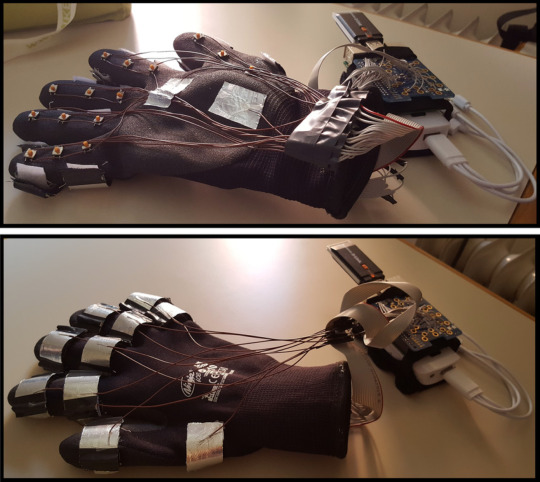
All in all, soft circuit brings more benefits then shortcomings, as it is a great step of improvement for technology, more importantly, it did help a lot of people who are in need.
References:
B., & M. (n.d.). Firefly Jar Assembly Guide. Retrieved from https://learn.sparkfun.com/tutorials/firefly-jar-assembly-guide/all
Draper, S. (2018, November 26). Deaf People Can Now Enjoy Concert with this Wearable Tech to Listen to Music Through Their Skin. Retrieved from https://www.wearable-technologies.com/2018/11/deaf-people-can-now-enjoy-concert-with-this-wearable-tech-to-listen-to-music-through-their-skin/
0 notes
Text
SM3511 Interface Design Week 4 Reflection
“Be personal. Be relevant. Be specific.” A quote by Seth Godin which I think is quite suitable for concluding this lecture, as the idea of contextual design is to create a prototype and design it specifically for our users.
From the reading assigned for this lecture, I acknowledged the importance of a good contextual design. Good designs would lead to a greater usability, whereas poor designs would end up arguing over design alternatives, considering everything over and over again.
In addition, I have learned more about the current contextual designs from today’s lecture, in which short forms, passive voice and cursive fonts of writing should not be used, as well as the dying out of splash screens, whereas simple present tense and short sentences are preferred.
However, I like splash screens personally though it is not trending in most of the countries. Websites like https://web.uj.com.tw/uj/game/FS/ and some of the mobile games start with a short video about the game, and I enjoyed watching it. I understand the change of the trend that these videos may consume more time for the consumers to access the main web page, but I don’t mind watching them.
0 notes
Text
SM3511 Interface Design Week 3 Reflection
“Alone we can do so little; together we can do so much.” A quote by Helen Keller, explaining the power of teamwork, just like the heuristic evaluation of user interfaces. The heuristic evaluation requires people with a different gender, race, and background to form as a group to evaluate the current interface design. The more experts who come from a different field, shall lead to a more diverse perspective of evaluating the current design.
From the reading assigned this week, there are a total of four experiments carried out. They invited the university students who were currently studying in the course of interface design with a major in Computer Science, as well as readers of the Danish Computerworld magazine to carry out the heuristic evaluation. Several usability problems were then been found out, and the results showed that different individuals would discover different problems for the same interface design, in which the more experts from different fields are invited, would construct a better result.
I had not overcome a large problem on the interface design of what I used, but a minor problem on the controls of my PS4, due to the different settings of different games. Normally, the X button is used to quit menus, whereas the O button is used to proceed to the next page. Yet, there is a game with X and O buttons as the opposite control, which makes me feel not as familiarized.
All in all, I think that heuristic evaluation eliminates a lot of major and minor problems, which makes our lives a lot easier.
0 notes
Text
SM3511 Interface Design Week 2 Reflection
Cheung Cheuk Wa Cherry (54794439)
“Everything is designed. Few things are designed well.” - a quote by Brian Reed. After reading the first few chapters of the book The Design of Everyday Things by Donald A. Norman and participating in this lecture, I can feel the quote and the importance of UI and UX design to our everyday lives.
I realized how products evolve, and the convenience brought by the evolution. Take telephone as an example from the book, without visuals helping the digital design, it is very complex for one to know how to hold a phone call, or a multi-people conference call. The mobile phones nowadays can however show the improvement of implementing and using these functions.
The development of technology is important, but so as the user experience. If there is a good invention, but it is hard to use, it would decrease the usability of a certain part of the technology. For example, the math calculator that I used for my Maths lesson back in my Secondary. There are actually plenty of functions that we can manually add into it, but I would not be able to access and use up all of them, in which makes the unused functions useless.
0 notes